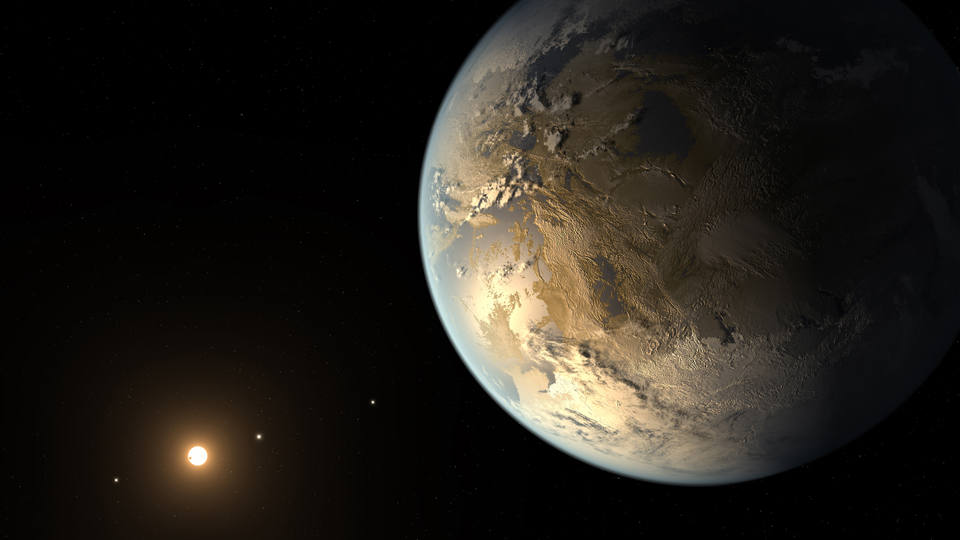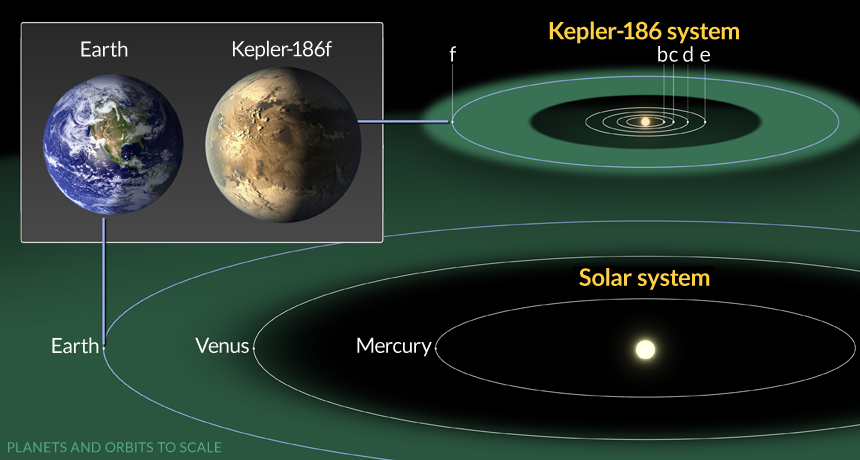Earth-sized planet found in star’s habitable zone
Exoplanet could have liquid water, which astronomers consider crucial for possible alien life

A LOT LIKE HOME An Earth-sized planet capable of hosting liquid water and four other worlds orbit the cool red star Kepler-186, as seen in an artist’s illustration. The planet, found in data from the Kepler space telescope, is the smallest planet found in a star’s habitable zone.
NASA Ames, SETI Institute, JPL-Caltech
- More than 2 years ago
Earth, meet your distant cousin. The Kepler space telescope has turned up a potentially water-bearing world nearly as small as our planet. The planet is the smallest one found in any star’s habitable zone, a temperate region surrounding a star that is suitable for liquid water.
Elisa Quintana, an astronomer at the NASA Ames Research Center in Moffett Field, Calif., and colleagues discovered the planet, Kepler-186f, in data from the first three years of Kepler’s mission. The planet is 10 percent larger than Earth and orbits a type of star called an M dwarf, a red star that is smaller, cooler and fainter than the sun. The planet circles the star Kepler-186 once every 130 days in an orbit slightly smaller than Mercury’s. The star, which is 490 light-years away in the Cygnus constellation, also hosts four other roughly Earth-sized planets. Previously discovered by Kepler, the other planets are much closer to the star, whipping around in as little as 3.9 days. Each of the planets was found using the tiny dips in starlight it creates when it passes in front of, or transits, Kepler-186.
“M dwarfs are now becoming everybody’s darlings,” says Jill Tarter, former director of the Center for SETI Research in Mountain View, Calif. “They’re the low-hanging fruit.” Potentially habitable planets are easier to find around M stars because the habitable zones are relatively close to the cool stars. Close planets are easier to detect because they are more likely to transit their stars than more distant ones.
M stars are also the most common type of star in the Milky Way, making up roughly three-quarters of known stars. “If we find that Earth-sized planets around habitable zones of M stars are common,” says coauthor Thomas Barclay, also a NASA Ames astronomer, “that means they’re common throughout the galaxy.”
However, he adds, “Just because it’s in the habitable zone doesn’t mean it’s habitable.” Since the planet orbits a faint star a long way from Earth, follow-up observations will be difficult. Without examining the planet’s atmosphere — or even knowing whether it has one — researchers can’t be certain that liquid water exists on the surface.

While a flare might wipe out emerging life or strip a planet of its atmosphere, the fluctuating environment around an M star could instead provide some benefits. “Change can be catastrophic,” says Margaret Turnbull, an astrobiologist at the Global Science Institute in Antigo, Wis., but it can also be “inspirational for life.” Earth’s cataclysmic collisions with comets and asteroids, for instance, not only triggered mass extinctions but also opened up new niches for life to flourish.
Despite long odds for life, Tarter says early news of the discovery prompted SETI scientists to undertake a two-week search for radio transmissions from around Kepler-186, in the faint hope of listening in on an alien civilization. “It caught our attention,” she says. The search came up empty-handed.
If Kepler-186f is home to life, it would live in an environment completely foreign to Earth. M dwarfs emit mostly red and infrared light. On Earth, plants harvest higher-energy wavelengths of light for photosynthesis. However, some cyanobacteria perform photosynthesis with light slightly redder than visible light.
While follow-up observations are difficult for the distant planets found by Kepler, Barclay says, the telescope’s data will help engineers design next-generation space telescopes and know where to point them. The Transiting Exoplanet Survey Satellite, scheduled to launch in 2017, will look for planets around the M stars closest to Earth. The James Webb Space Telescope, due to launch a year later, will examine the atmospheres of many of those nearby planets. “There’s no reason that we couldn’t be surrounded,” Turnbull says, by planet-bearing stars resembling Kepler-186.







